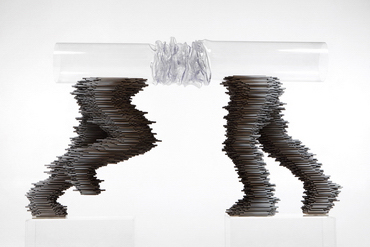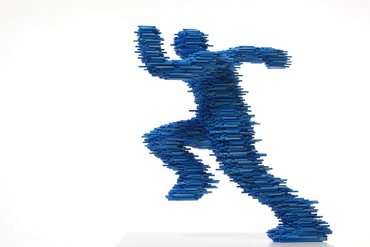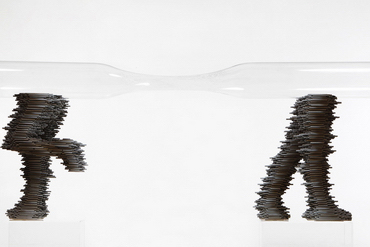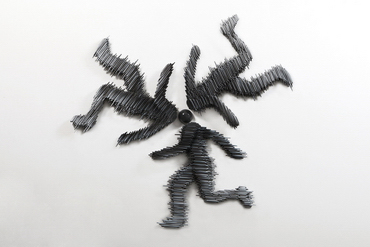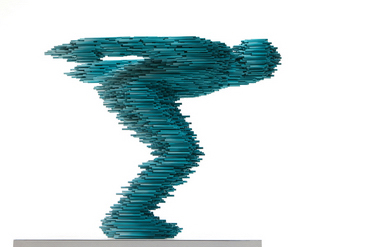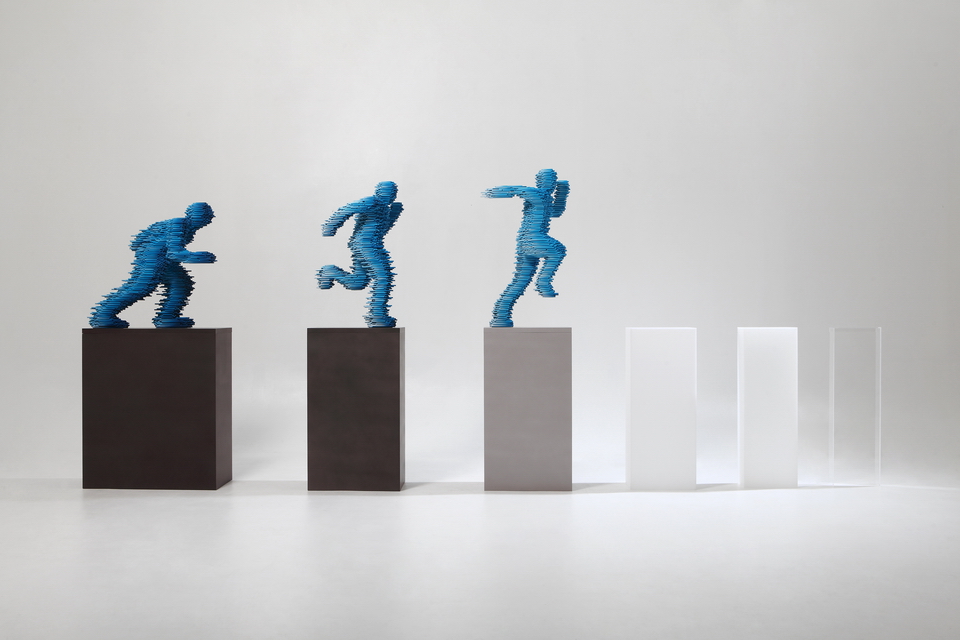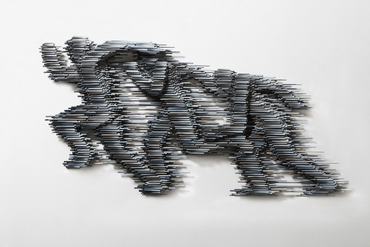속도의 무브먼트
• 아첼레란도의 진보속도
‘속도가 우리의 삶에 야기한 경험들은 무엇인가.’ 그리고 이에 대해 ‘우리시대의 예술(contemporary art)은 어떠한 현재적 시각들을 던지고 있는가.’ 이 물음에 대해 20세기 예술은 이미 기계시대를 미적이상으로 앙망하며 속도개념을 조형적 가치로 요구하였던 미래주의의 역동적 내러티브를 통해서 그것을 설파한바 있다. 그러나 그들의 속도는 ‘삶의 고정성을 움직임 속에 갖다’ 놓는 일에 너무도 열중했다. 속도의 아름다움에 대한 마리네티(Filippo T. Marinetti)의 격한 감정의 선언은 지금 숭고한 안락감으로 낭독되며 ‘움직임 속에 삶을 고정’시키는 일종의 감각적 마취제로 투여되고 있다. 그 감각적 쇼크 속에서 ‘동시다발적 현전’은 몰입적 환영을 창조하며 모든 재현을 능가하는 폭정의 원근법으로 펼쳐지고 있다. 환영으로 일그러진 그 원근법 속에서 일상적 세계를 구성하는 실제적인 것들은 한없이 축소되면서 거대한 오브제들 속으로 빨려 들어가고 우리의 지각적 경험의 시각은 점점 흐릿해진다. “끊임없는 진보가 내리는 저주는 끊임없는 퇴행이다”라는 아도르노(Theodor W. Adorno)의 말처럼, 아첼레란도의 진보속도는 우리의 삶을 점점 진보시키고 있지만, 우리의 시각은 점점 퇴행되어가고 있다. 흐릿해지는 시력으로 우리는 <00:00:00:00Ⅰ> 에 초점을 맞추며 두 눈을 게슴츠레하게 뜨기도 하고 깜빡거려보기도 하지만, 그 형상을 응시하면 할수록 소멸되듯 쏜살같이 스쳐가는 그 이미지의 잔상들이 겹쳐지면서 시야는 더욱 혼란스러워진다. 그럼에도 불구하고, 연속적 움직임 ‘사이, 사이’에 ‘낀’ 것들, 말하자면 낯익은 형태와 그 배경에서 분명히 드러나지 않는 모습들을 지각하고 싶은 열망, 왜상을 끌어들여서라도 그것을 확인해보고 싶은 우리의 시각적 욕망은 점점 또렷해지는 듯하다.
• 다발(多發)적 순간의 클러스터
2007년부터 현대사회의 일상 속에서 찰나적 동세(movement)를 PVC파이프로 고정시켜 왔던 강덕봉은 2010년 《HIDE》展을 기점으로 그 찰나적 순간에 ‘숨어있거나 가려져 보이지 않는’ 움직임들을 하나의 파이프 다발(cluster)로 묶어내기 시작했다. 가속도가 붙은 그러한 순간들에 적극적으로 자신을 실은 작가는 2013년 《속도의 무브먼트》展을 통해서 그 찰나적 순간들에서 흩뿌려지는 ‘동시다발적 움직임들’의 클러스터를 생성해내기에 이르렀다. 말하자면, 이전의 작품들이 파이프의 무게와 부피로 ‘정지된’ 조형적 형상을 한 덩어리로 조합해내는데 불과했다면, 이후로부터는 ‘정태적’ 조형을 강한 휘발성을 지닌 형체들로 세밀하게 분할하기 하고 그러모으기도 하는 변화를 보이고 있는 것이다. 현재, 작가는 역동적으로 움직이는 그 순간순간을 스냅사진으로 찍어내듯 응결된 조형적 시퀀스를 파이프 다발로 구성하고 있다. 마치 초인적 의지력으로 그 순간의 시간을 경험하는데서 오는 모순들을 하나로 묶으려는 강덕봉의 조형적 시도는 앞선 미래주의자들의 통합적 상태에 대한 고양된 의식을 엿보게도 한다. 예컨대 그들이 인간을 그릴 때 수많은 사지를 연속 또는 방사형으로 중복시키며 역동적 움직임과 찰나적 광선을 포착해낸 연속적 장면과도 유사하다 할 것이다. 그러나 ‘우리시대의 예술’에서 그리고 강덕봉에게서 미래주의를 재호출한다면, 그 의미는 스펙터클로 질주하는 현대속도사회에 관해 다시 측정할 수 있도록 하는 ‘매개자’가 되어 그 질주학적 진화에 관한 모순의 증상들을 환기시키는 것으로 주목해야 할 것이다.
속도감있게 전개되는 한 장면을 연속 촬영하여 묶어 낸 것과 같은 그 조형적 형상들은 분명 그 찰나적 순간에 발생하고 있는 무브먼트 다발이다. 다시 말해, 그 형상들을 구축하는 파이프 부재(部材)는 그 찰나에 동시적으로 발생하는 어떤 유사한 상황의 데이터를 결집시켜 놓은 ‘클러스터’이자, 이에 대한 입출력장치와도 같은 조형적 서브시스템 ‘매체’라 할 수 있다. 작가는 가는 파이프 관과 그 통으로 켜켜이 쌓아 올린 역동적 형상들에 그러데이션 효과를 더하여 조각적 무게감을 속도의 빛에 의해 부서지는 파편적 잔상들로 흩뿌려 놓는다. 이러한 색채의 프리즘적 재현은 그 형상이 마치 무언가가 쏜살같이 지나가고 난 뒤에 지평선 상에 인광으로 인해 희미한 실루엣으로 남겨지는 착시를 배가시켜 준다. 일례로 <00:00:00:00Ⅰ>에서 (전시장)바닥면과 연결된 것 같은 좌대 지평에서 저 편을 향해 달려가는 축소화된 인체들은 사실상 움직이지 않는 대상들이다. 그러나 이것들은 지표면 위로 오르며 앞으로 달려 나가는 순간, 빠르게 사라지는 연속체의 실제물이며, 관찰자인 우리의 초점 그 자체가 되어 인광으로 우리에게 던져지면서 우리의 눈을 부시게 하여 그 질주의 풍경 속으로 우리를 매몰시킨다. 이러한 매몰적 장면은 2점의 부조작품, 세 개의 몸에 하나의 머리를 가진 인체들이 크로노스적 시간계를 빙빙 돌아가는 듯한 , 그리고 그 시간의 궤도 속으로 질주하는 인체의 이동성을 직선의 가는 파이프를 사용하여 선적 드로잉처럼 평면화시킨 <00:00:00:00Ⅱ>에서도 연결된다. 가속도로 인해 흩뿌려지는 그 형체들은 속도의 쾌락 속에서 그러데이션 효과처럼 짙어지거나 엷어지면서 희미한 실루엣으로만 남겨진다. 강하게 다가온 그 견고한 덩어리들은 차갑게 사라지며 우리의 물리적 공간과 심리적 공간으로 모호하게 녹아들어간다.
비릴리오는 『속도와 정치(1977)』에서 우리가 속도 세계에 진입한다는 것이 곧 ‘속도의 정치경제학’에 들어선 것과 마찬가지라고 본다. 그는 과거의 속도가 존재자인 우리의 생존율을 높이며 안락을 가져다주었지만, 현대의 속도는 우리 존재자에 대한 위협이 아니라 존재 그 자체에 대한 위험이라고 주장한다. 말하자면, 지금의 질주속도는 우리를 심리적 순응주의에 젖어들게 하면서 이내 모든 판단의 상실을 초래한다고 본 것이다. 더욱이 이러한 세계는 극한에 다다른 속도 속에서 정주를 이루게 하며, 뭔가를 하기 위해 한 지점에서 다른 지점으로 굳이 이동할 필요가 없는 ‘극의 관성’을 안착시킨다. ‘극의 관성’이라는 운동이 독재하면서 사물(또는 사람)의 부동성이 서서히 또는 갑작스럽게 드러나는데, 이러한 현상들이 우리 존재를 은밀하게 내파하며 의지 없는 신체들을 창출해내고 있다. 작가는 와 에서 몸에 속도를 부여하는 다리의 움직임만을 그 부동적 상황에서 뜯어내어 ‘극의 관성’에서 벗어나려는 운동을 재현해낸다. 그러나 그것을 벗어나려는 다리의 움직임들은 그 운동의 독재로 인해 충돌과 충격의 연속을 펼쳐내며 독점된 시간계로 끌려가면서 순응적 감각에 더욱 단단히 붙들려 정박당할 뿐이다. 그리고 그 다리들 위에 텅 빈 투명관은 실제 (전시)공간 ‘속’에 우리의 신체와 연결되는 배관으로 놓이며 보이지 않는 독재적 운동을 내파시킨다. 자유롭게 운동할 수 없는 그 다리들과 우리의 신체는 은밀하게 침투하고 습격하는 속도에 통합되어 가고 있다. 그 속도는 불안한 순간들을 끊임없이 만들어내면서 우연한 현상들은 억누르며 사물(또는 사람)이 나타나는 방식을 결정지으려 한다. • 콘 모토 무브먼트
그럼에도 불구하고, 살아있는 신체는 불안정을 유지함으로 매순간 다르게 문제를 설정하며 살아있음을 유지한다. 즉 존재한다는 것은 끊임없이 변화한다는 것이다. 그렇다면, 속도에의 시간은 결코 단순히 그 안에 존재하고 그것에 박혀있는 것만은 아닐 것이다. 아마도 이를 인지한 작가는 작품의 제목을 시간기록으로 표기하면서 숫자로 표현될 수 있는 속도가 지배하는 매끄러운 세계를 자신만의 거친 시간으로 재측정하려 했을 것이다. 그러한 측정법을 통해서 작가는 이 상태에서 저 상태로 이동하는 움직임보다는 자신이 체험한 속도와 접촉하면서 다양한 시각적 종횡운동을 기록하여, 그것을 느끼는 시간을 자신만의 속도로 다시 변경하고자 했을 것이다. 더불어 이는 그의 형상들이 표면적으로 부동의 상태이지만 결코 정주적 상태가 아니라, 끊임없는 운동 상태 ‘속’에서 모아지고 있는 순간들의 클러스터임을 강조해준다. 예컨대 텅 빈 공간일지라도, 그 곳은 비어 있는 것이 아니라 무한한 먼지와 같은 미세입자들로 꽉 찬 공간이다. 그러한 공간에 사람이든 사물이든 들어간다면, 그 순간 입자들은 미묘한 운동을 시작할 것이다. 이 미묘한 운동은 강덕봉이 파이프로 구축한 역동적 움직임의 겉모습과는 달리 텅 비어 있는 그 내부 공간이 미세한 운동관으로 역할하고 있음을 부연해주기도 한다. 즉 그의 파이프들은 우리의 용인된 시야에서 가려져 보이지 않는 ‘사이, 사이’의 순간들을 ‘끼어’ 나가며 마련된 미세한 입자들이 들고 나는 클러스터인 것이다. 이러한 상황 속에서 우리 역시 우리의 운동 상태에 따라 저마다의 고유한 시간과 마주하며 무한히 느려지기도, 무한히 빨라지기도 하면서 우리 안에 관성적 시간 감각에 서서히 균열을 일으키게 된다.
이제, 우리는 지평 너머 ‘더 멀리’를 동경하기 보다는 우리시대에 들이닥치고 있는 속도의 질주 ‘사이, 사이’의 흐름을 연속시켜가며, 이미 순간순간 지나친, 아니 잃어버린 현실의 부재들에 대해 반응을 시작해야 한다. 이는 다양한 ‘움직임을 가지고(con moto)’ 아첼레란도의 진보속도로 펼쳐지는 질주의 풍경을 우리 자신만의 템포로 측정하며 다양한 속도를 주파하는 흐름을 살아가는 것이다. 이를 위해 ‘우리시대의 예술’은 그러한 질주학적 진화의 세계에 대해 이의를 제기하며 새로운 조형적 형태의 기보법을 개발하고 다양한 합주를 끊임없이 지휘해야 한다. 이와 함께 우리시대의 예술가 역시 속도의 질주로 인해 지나친 현실의 부재들에 대해서 자신만의 끈질긴 숙고와 저항의 속도를 실험해야 한다. 그러한 개개인들의 새로운 미학적 실험과 발명이 ‘속도의 무브먼트’라는 연계적 운동으로 이어진다면, 성찰능력과 결정능력을 박탈해버릴 위험이 있는 속도에 대한 하나의 저항적 흐름을 펼쳐낼 수 있을 지도 모른다. 그렇기에 ‘속도’라는 개념을 자신의 예술적 사유에 중심으로 놓은 강덕봉이 이번 전시를 통해 시작한 자신만의 시간으로 기록하는 움직임은 “속도의 무브먼트”라는 흐름을 분기하고, 발산하는 작은 예술적 클러스터로 다져질 수도 있을 것이다. 그리고 그 역시 이러한 속도의 운동을 자신의 작품에 끊임없이 들고 나게 하기 위해서, 이제부터는 속도의 ‘움직임 속에 고정된 삶’을 ‘다양한 삶으로 움직이게 하는 속도’로 전환시키는 역동적 과정을 더 깊이 사유해야 할 것이다.
Movement of Speed
• Accelerando in progress
A question is posed: ‘What experiences were brought to our lives by speed?’ Another question is what viewpoint does contemporary art take toward this? With the dynamic narrative of the Futurists, art in the Twentieth century had once promoted the value of speed through a visual language revering the era of machine as their ideal aesthetics. Their speed, however, overly focused on ‘placing the fixity of life onto movement’. This fiery manifesto towards the beauty of speed by Filippo T. Marinetti is now read with the tone of sublime comfort and serves as a type of anesthetic for the senses, which ‘fixates life to movement’. A ‘simultaneous epiphany’ within the sensory shock creates an immersive fantasy and extends into a tyrannical perspective surpassing every representation. The real material that composes the everyday world is distorted in our perspectives thanks to fantasy, which is endlessly reduced and absorbed by huge objects, thereby blurring our views of perceptive experiences. As Theodor W. Adorno said, ‘the curse of incessant progress is endless regress.’ The accelerated speed of progress brings forth increasing advancements in our lives, and yet our vision becomes more and more skewed. With blurred vision and half-closed or blinking eyes we manage to focus on 00:00:00:00Ⅰ, and still the afterimages of the work begin to overlap and create more confusion, fleeting with an arrow-like speed despite our efforts to look more intensely. Nevertheless, even with the help of distortions, we seem to have stronger desire to see things ‘inserted’ clearly between continuous movement, or in other words, to see familiar forms and the things blurred out of the background.
• Simultaneous clusters of moments
Having captured momentary movements within the everyday routines of modern day life since 2007, Kang Duck-bong began to tie the ‘hidden or unseen’ movements together with clusters of pipes in the 2010 exhibition HIDE. Relying on the moments when speed becomes full-blown in its acceleration, in 2013’s Movement of Speed Kang sought to generate clusters of simultaneous movements which are then shattered into fleeting moments. Or to put it another way, the earlier works assembled ‘standstill‘ forms with the weight and mass of pipes, while the current work divides the ‘static’ forms into fleeting pieces, occasionally drawing them back together again.. At present, the artist, as if taking snapshots of each moment of dynamic movement, constructs his encapsulated visual sequences into pipe clusters. Kang’s superhuman attempt to visually capture the contradictions that come out of the experiences of these moments, gives us a glimpse into the refined consciousness of the integrated state of the Futurist. For instance, the works are similar to Futurist images of figures drawn with numerous overlapping limbs in continuous or radial forms, conveying dynamism and momentary rays of light. However when Futurism is brought up in Kang’s work ‘in the current art scene’, its significance would lie in his role as a ‘mediator’ measuring modern society as it races with spectacular speed, and evoke contradictory symptoms out of this reckless pace.
The three-dimensional forms, which seem to have been produced by mixing continuously shot images of a quickly developing scene, are definitely movement clusters occurring within a fleeting moment. In other words, as the material that is constructing these forms, the pipes also create a cluster that alludes to the data of a certain similar situation occurring simultaneously and instantly. Kang adds gradated effects to the dynamic constructions, made by stacking up thin pipes one by one and turning the sculptural mass into fragmental afterimages shattered by speed’s light. These prism-like representations of color double as optical illusion that leave us seeing hazy silhouettes due to phosphorescence on the horizon, as if something has passed through like an arrow. For instance, in 00:00:00:00Ⅰ the reduced human figures, racing away from us on a base seemingly connected with the (exhibition hall) floor, are in actuality, immobile objects. These are, however, the substantial objects of the rapidly disappearing continuum, the moment they rise up above the ground level and run forward. They emit phosphorescence to the observer, making him or her feel dazzled and overwhelmed by the scene racing by. Such awe-inspiring scenes are also featured in 99:59:59:99—in which human forms with a head and three bodies seemingly circle around Chronos’ system of time—as well as in 00:00:00:00Ⅱ in which the motion of a human form can be traced racing along the trajectory of time. The work is flattened like a linear drawing through the use of Kang’s thin straight pipes. The forms, which are fragmented due to their acceleration, are left with blurry silhouettes as they become thicker or thinner in a gradated effect within the intoxicating speed. These solid masses, despite their usual strength, disappear into the cold, and melt a little into the viewer’s physical and psychological spaces.
In Vitesse et Politique: Essai de Dromologie (1977) Virilio suggests that entering the world of speed means we are introduced to the ‘political economy of speed’. He argues that, in previous eras, speed brought comfort to us by increasing our survival rate, while the speed of modern times serves as a risk to our own existence, not just as a threat to our being. In other words, Virilio sees the current accelerated sense of speed as bringing us to a point where we are immersed within a psychological conformity and no longer able to judge. In addition, such a world as this comes to a halt at an extreme level of speed, reaching an ‘extreme inertia’ in which a person doesn’t need to move from one point to another to make something happen. As the movement of ‘extreme inertia’ governs, the immobility of objects (or humans) appears gradually or abruptly, and this phenomenon stealthily implodes within our being, creating bodies devoid of willingness. Kang realizes the type of movement that helps us to avoid ‘extreme inertia’ by focusing on the motion of legs within an otherwise immobile situation. However the motion of legs creates a series of collisions and shocks due to the ‘extreme inertia’ that is prevalent and yet it still comes to a halt by getting stuck within the conforming sensory experiences, gravitating only towards the temporal system of speed. An empty transparent pipe on the legs implicitly breaks down the invisible dictatorial movement because of the way that it implies a connection to the viewer’s bodies ‘within’ the actual (exhibition) space. The immobile legs and the viewer’s bodies become integrated within this covertly invading and attacking speed. The speed never ceases to create uneasiness, suppressing possible coincidences and determining how objects (or humans) function.
Nevertheless, the living body is still alive, maintaining such uneasiness and setting up different issues every minute. In other words, to live is to endlessly change. Therefore the life that relies on speed neither simply exists within speed, nor is it fixed onto it. The artist marked the titles with a time stamp, perhaps in an intention to measure, in his own rough way, the sleek world dominated by a speed that is marked by numbers. Perhaps rather than being passively moved from here to there, the artist transforms the overwhelming speed to his own, by recording a variety of up/down and right/left movements visually, based on his experiences of speed. In addition, this underlines the point that, externally, his constructs stay immobile, although far from being in standstill, instead serving as clusters of moments gathered within this endless motion. For instance, even the empty space it is not a void but full of fine particles like immeasurable bits of dust. If anything invades such a space, whether it be a human or an object, the particles immediately begin subtle movements. The delicate motion expands from the point that the empty inner space serves as a pipe, bringing hardly perceptible motion, in contrast to the dynamic movement portrayed with the pipe sculptures. In other words, his pipes act as a cluster that minute particles pass through, as they escape from the moments between the gaps that are hidden and invisible in our limited views. Within this situation, the viewer, depending on their state of movement, slowly brings forth fission to inertia, by encountering one’s own temporal senses, becoming interminably slow, or fast. Now we continue the flow between the gaps found in the accelerated movement, and should respond to the things overlooked and lost in each moment of reality, rather than yearning for that which is ‘further’, beyond the horizon. This refers to leading a life with one’s own temporal measurement and a variety of movements (con moto), resistant to the racing in the accelerated speed of progress. ‘Art in our times’ should raise objections, develop the rhythm and score of a new visual language, and command a variety of ensemble. As well as this, artists in our times also ought to maintain a persistent contemplation of one’s own, as well as experiments of resistance in regards to the overlooked absences of reality, caused by the accelerated pace. If each artist’s aesthetic experiment spreads out as a ‘movement of speed’, there might be a resistant stream against speed which may deprive one of abilities to contemplate and conceptualize. Therefore Kang, having placed the concept of ‘speed’ at the center of his aesthetic thinking, may raise a flow of ‘movement of speed’ and turn his suggestion of one’s own temporal record into a small artistic cluster which can be extended. In addition, it seems vital that he keep working hard to convert a ‘life fixated with speed’ into life ‘free-flowing within a variety of speeds’, in order to encompass the movement of speed within his work.
